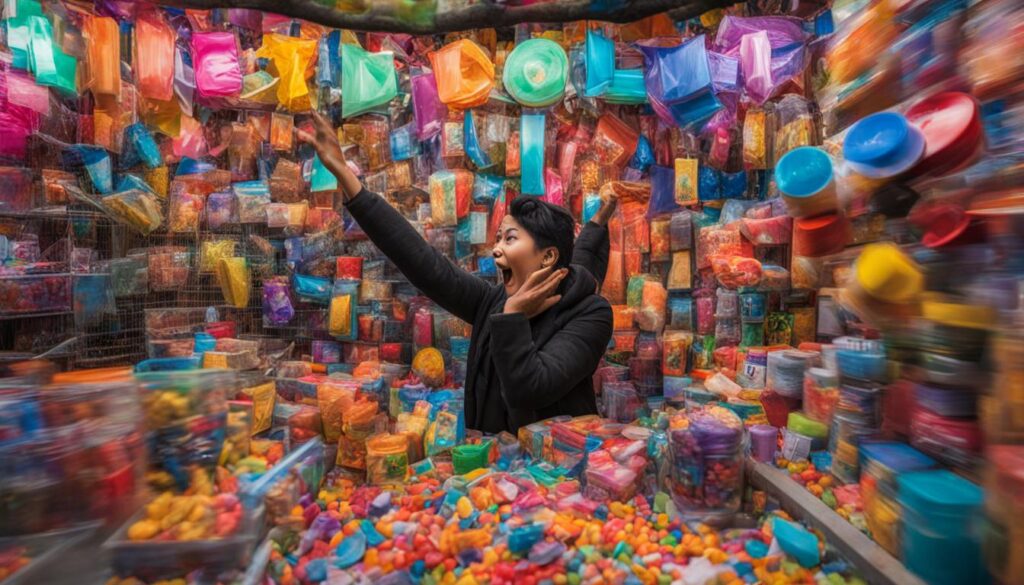Impulse buying is a common phenomenon that often results in emotional spending and unplanned purchases. Whether it’s a last-minute online shopping spree or an impulsive splurge at the mall, our emotions play a significant role in these decisions. In this article, we will explore the influence of scarcity on impulse purchases, the emotional triggers that drive our choices, and the strategies marketers use to exploit these behaviors.
Key Takeaways
- Impulse buying is driven by emotional triggers and the desire for immediate gratification.
- Factors like fear of missing out (FOMO), social proof, scarcity, and exclusivity play a significant role in impulsive purchases.
- Understanding the psychology behind impulse buying is essential for both marketers and individuals looking to manage their spending habits.
- Marketing strategies like limited-time offers, upselling, and cross-selling can exploit emotional triggers to increase sales.
- By implementing practical strategies and focusing on long-term financial goals, individuals can regain control over impulse buying behaviors and achieve financial stability.
What is Impulse Buying?
Impulse buying can be defined as a sudden and unplanned decision to purchase a product or service. It is driven by emotional triggers and the desire for immediate gratification. Impulse buying is often influenced by basic needs and desires, such as physiological, safety, social, esteem, and self-actualization needs. Factors like marketing, advertising, brand loyalty, and product scarcity can also influence impulse buying behavior. However, impulse buying can lead to feelings of regret or guilt after the purchase if the item does not satisfy long-term needs or desires.
Impulse buying is a common phenomenon that many individuals experience at some point in their lives. It can be triggered by various emotions, such as excitement, happiness, or the need to reward oneself. The impulse to buy something arises suddenly, often without much thought or consideration for the long-term consequences.
Immediate gratification is a key driver of impulse buying. People seek the instant pleasure and satisfaction that comes from acquiring something new and exciting. Whether it’s a trendy fashion item, the latest gadget, or a tempting treat, the desire for immediate gratification can override rational decision-making.
Emotional triggers play a significant role in impulse buying. Marketers understand this and use various tactics to capitalize on consumers’ emotions and drive sales. They create persuasive advertisements that pull at our heartstrings, use catchy slogans and jingles, and design eye-catching displays to attract attention. Marketers also tap into the fear of missing out (FOMO), creating a sense of urgency and scarcity to compel immediate action.
Impulse buying is often driven by emotional triggers and the desire for immediate gratification.
However, impulse buying is not without its downsides. It can lead to financial strain and overspending, especially when individuals make impulsive purchases that they later regret. It is crucial to strike a balance between satisfying immediate desires and considering long-term needs and goals.
Understanding the psychology behind impulse buying can help individuals make more informed purchasing decisions. By recognizing emotional triggers and the allure of instant gratification, individuals can develop strategies to manage impulse buying tendencies. This may involve creating a budget, practicing mindful spending, and evaluating purchases based on their long-term value.
| Emotional triggers | Influences on Impulse Buying |
|---|---|
| Fear of missing out (FOMO) | Social proof |
| Scarcity | Exclusivity |
Factors that Influence Impulse Buying
When it comes to impulse buying, emotions play a crucial role in influencing consumer behavior. Understanding the various emotional triggers can help marketers harness their power and increase sales. Let’s explore some of the key factors that influence impulse buying:
1. Fear of Missing Out (FOMO)
Fear of missing out is a powerful emotional trigger that drives individuals to make impulsive purchases. People are afraid of not being included or missing out on something desirable. Marketers often tap into this fear by creating a sense of urgency and scarcity around a product or limited-time offer.
2. Social Proof
Social proof is another influential factor in impulse buying. When individuals see others engaging in a particular behavior, they are more likely to follow suit. Marketers leverage social proof by showcasing testimonials, reviews, and user-generated content to instill trust and encourage potential buyers to make a purchase.
3. Scarcity
The concept of scarcity taps into our innate fear of missing out on a valuable opportunity. When a product is perceived as scarce or in limited supply, it triggers a sense of urgency. Marketers often emphasize scarcity by highlighting the limited quantities or time-bound offers, compelling consumers to act quickly before they miss out.
4. Exclusivity
The desire for exclusivity drives individuals to seek out unique products or experiences that make them feel special or superior. Brands that offer limited edition or exclusive items appeal to this emotional trigger. By creating a sense of exclusivity, marketers can tap into consumers’ desire for status and differentiate their products from competitors.
By understanding and strategically utilizing these emotional triggers, marketers can effectively encourage impulse buying. However, it is crucial to use these triggers responsibly and ethically, as overuse or manipulation may lead to negative consequences and damage brand loyalty.
| Emotional Triggers | Impact on Impulse Buying |
|---|---|
| Fear of Missing Out (FOMO) | Creates a sense of urgency and desire to not miss out on opportunities |
| Social Proof | Builds trust and encourages individuals to follow the behavior of others |
| Scarcity | Creates a perception of limited availability, triggering a sense of urgency |
| Exclusivity | Appeals to the desire for uniqueness and status |
Social Influences on Impulse Buying
Social influences have a significant impact on impulse buying behavior. People are often swayed by those in their social circles, including friends, family, and even strangers. These social interactions can shape consumer purchasing decisions in various ways, driven by phenomena such as social proof, influence from authority figures, and the pressure to conform.
Social proof, for instance, is a powerful force in impulse buying. When individuals observe others engaging in a particular behavior, they tend to follow suit. This can be witnessed in the context of consumer purchases, where individuals are more likely to buy a product if they see others doing the same. It reinforces the notion that if “everyone else” is doing it, it must be the right choice.
Authority figures also hold sway over consumer behaviors. Celebrities and experts, for example, have the power to influence impulse purchases simply by endorsing a product or service. When someone perceived as knowledgeable or influential vouches for a particular item, it can create a sense of trust and desirability among consumers.
Additionally, peer pressure can lead to impulsive buying decisions. Individuals may feel the need to fit in with their social group or fear being left out if they do not conform to certain purchasing choices. This pressure to conform and maintain social relationships can drive individuals to make impulsive purchases they may not have otherwise considered.
Examples of Social Influence Strategies
Marketers understand the power of social influences and often employ various strategies to capitalize on them. Some common tactics include:
- Using testimonials or reviews from satisfied customers to establish social proof
- Utilizing celebrity endorsements to influence consumer perceptions and behaviors
- Employing targeted advertising that aligns with the values and aspirations of specific social groups
By understanding the impact of social influences on impulse buying, marketers can design effective campaigns that trigger emotional responses and encourage immediate purchases.

| Social Influences | Impact on Impulse Buying |
|---|---|
| Social Proof | Encourages individuals to follow others’ behavior, increasing the likelihood of impulse buying |
| Authority Figures | Influence consumer decisions through endorsements and perceived expertise |
| Peer Pressure | Drives individuals to make impulsive purchases to fit in or avoid social isolation |
Marketing Strategies for Impulse Buying
Marketing strategies play a critical role in influencing impulse buying behaviors. Companies employ various tactics to capitalize on consumers’ emotional triggers and drive immediate purchases.
Limited-Time Offers and Discounts
One effective strategy is the use of limited-time offers and discounts to create a sense of urgency. By incorporating time-bound promotions, marketers create a fear of missing out (FOMO) and encourage consumers to make impulsive buying decisions. Limited-time offers tap into consumers’ desire for immediate gratification, compelling them to take advantage of the offer before it expires.
Upselling and Cross-Selling
Another technique used by marketers is upselling and cross-selling. At the point of sale, companies offer complementary or upgraded products to enhance the shopping experience. Upselling suggests higher-end alternatives, while cross-selling encourages customers to consider additional items that complement their original purchase. By subtly enticing customers with related products, marketers increase the average order value and maximize revenue.
Influencer Endorsements
Influencers and celebrities are often leveraged to promote products, as their endorsement adds credibility and increases perceived value. By associating products with well-known personalities, marketers tap into consumers’ desire to emulate their favorite influencers, leading to impulsive buying decisions. The influence of these endorsers can create a sense of exclusivity and elevate the desirability of the product.
Creating Exclusivity and Scarcity
Creating a sense of exclusivity and scarcity can also motivate impulse buying. By positioning products as limited in quantity or available for a limited time, marketers cultivate a sense of urgency and encourage immediate purchases. This taps into consumers’ fear of missing out and enhances the perception of the product’s value.
Understanding Consumer Needs and Emotional Triggers
Effective marketing strategies for impulse buying require a deep understanding of consumer needs and emotional triggers. Marketers must align their messaging with the emotional factors that drive impulsive purchases. By crafting compelling narratives and appealing to consumers’ desires and aspirations, marketers can influence behavior and drive sales.

How Does Scarcity Influence Impulsive Buying Behavior?
Scarcity plays a significant role in advertising to sway impulsive buying behavior. When consumers perceive a limited supply of a product, the fear of missing out kicks in, triggering impulsive purchasing decisions. Marketers often use this tactic to create a sense of urgency and drive sales.
Does Scarcity Affect Impulsive Buying and Relationships in the Same Way?
When it comes to impulsive buying and relationships, scarcity’s impact on relationships can often mirror its effect on purchasing decisions. Just as limited availability can drive impulsive purchases, feeling scarcity in a relationship can lead to impulsive decisions and behaviors that may not be beneficial in the long run.
Conclusion
Emotional spending can have a significant impact on our financial well-being, but there are practical strategies we can implement to regain control over our financial decisions. By understanding the psychological triggers that drive impulsive buying behavior, we can develop self-control and achieve financial stability.
One effective strategy is to implement a 24-hour rule before making non-essential purchases. This allows us time to consider whether the purchase is truly necessary or driven by emotional impulses. Additionally, creating a budget that includes discretionary spending can help us prioritize our financial goals and avoid impulsive purchases.
Practicing mindful spending is another powerful strategy to curb emotional spending. By becoming more aware of our spending habits and questioning the motivations behind our purchases, we can make more intentional and informed choices. Building a support system, whether it is through friends, family, or online communities, can provide accountability and encouragement in maintaining self-control.
Lastly, aligning our actions with our financial goals is essential for achieving long-term financial stability. By balancing immediate gratification with the pursuit of our financial aspirations, we can make deliberate choices that lead us closer to financial empowerment and prosperity. Remember, every intentional decision brings us one step closer to the financial future we desire.
FAQ
What is impulse buying?
Impulse buying refers to the sudden urge to purchase items that were not previously planned for. It is driven by emotional triggers such as excitement, boredom, or stress.
What factors influence impulse buying?
Factors like advertising, product displays, pricing, and social influence can influence impulse buying behavior. Emotional triggers like fear of missing out (FOMO), social proof, scarcity, and exclusivity play a significant role in impulse buying.
How do emotional triggers influence impulse buying?
Emotional triggers like fear of missing out (FOMO), social proof, scarcity, and exclusivity create a sense of urgency or desire, leading to impulsive purchases. Marketers can manipulate these triggers to increase sales and foster brand loyalty.
What social influences impact impulse buying?
Social influences like social proof, authority figures, and peer pressure can heavily influence impulse buying. People are often influenced by the behavior of others, including friends, family, and celebrities.
What marketing strategies are used to encourage impulse buying?
Marketing strategies such as limited-time offers, discounts, upselling, cross-selling, and celebrity endorsements are employed to create a sense of urgency, enhance the shopping experience, and exploit emotional triggers to increase sales.
How can I manage my impulse buying habits?
To manage impulse buying, practical strategies include implementing a 24-hour rule before making non-essential purchases, creating a budget with discretionary spending, practicing mindful spending, building a support system, and aligning actions with financial goals.

